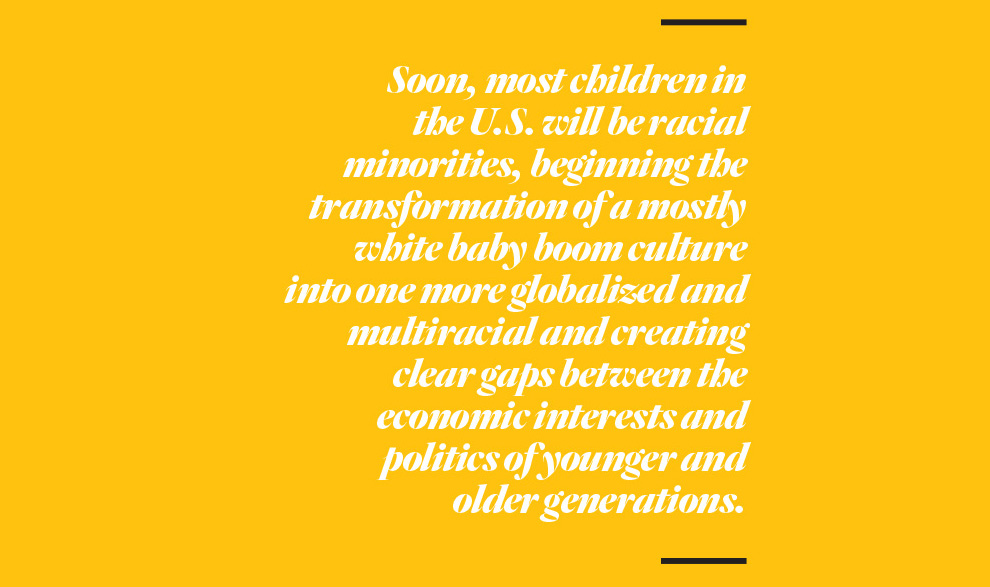If demography is destiny, the United States—much more than its peers—is on the cusp of great change. That change is due to a deep cultural generation gap at play, which will alter all aspects of American society within the coming decade.
Driving this generational gap is a “diversity explosion” in the United States, which began in 2011 when, for the first time in the history of the country, more minority babies than white babies were born in a year. Soon, most children in the U.S. will be racial minorities: Hispanics, blacks, Asians, and other nonwhite races. And, in about three decades, whites will constitute a minority of all Americans. This milestone signals the beginning of a transformation from the mostly white baby-boom culture that dominated the nation during the last half of the 20th century to the more globalized, multiracial country that the United States is becoming.
As the younger, more diverse part of the population reaches adulthood, clear gaps will develop between its economic interests and politics and those of the whiter, older generations. This divide will result in contests over local expenditures—for example, over whether to spend money on schools or senior health facilities—and those contests may evolve into culture clashes. Yet if demography is truly destiny, America's workforce, politics, and place on the world stage will soon be changed forever.
America's “new minorities”—particularly Hispanics and Asians—are becoming an increasingly strong thread in the social fabric of the United States. While this has been growing clearer for some time, recent information from the census and elsewhere shows how quickly these minorities are transforming the character of the nation’s youth. Consider the change in the U.S. population under age 18 in the first decade of the 2000s: From 2000 to 2010, the population of white children declined by 4.3 million while the child population in each of the newer minority groups—Hispanics, Asians, and people of two or more races—increased. Hispanics registered the largest absolute increase in children, 4.8 million. Were it not for Hispanics, the nation’s child population would have declined. And in 2010, slightly more than half of children under age 5 were white, while the oldest age group—those 85 and older—was 85 percent white. This diversification of the U.S. population from the bottom up holds more than just demographic significance. It reflects an emerging cultural divide between the young and the old as they adapt to change in different ways. Different age groups represent different generations, which were raised and became adults in specific eras and may be more or less receptive to the cultural changes brought about by new racial groups.
When viewed broadly, there is a sharp racial distinction between the baby boomers and their elders, and the younger generations—the millennials and young members of Generation X and their children, who constitute the population under the age of 35. Baby boomers and seniors are more than 70 percent white, with blacks representing the largest racial minority. In con-trast, millennials and young Gen Xers (largely under the age of 35) and their children are more than 40 percent minority, with Hispanics constituting the largest share of their minority population. A 2011 Pew Research Center poll shows that only 23 percent of baby boomers and seniors regard the country’s growing population of immigrants as a change for the better and that 42 percent see it as a change for the worse. More than one-half of white baby boomers and seniors said the growing number of newcomers from other countries represents a threat to traditional U.S. values and customs.
The resistance of baby boomers to demographic change may seem surprising. This much-celebrated generation came to embody the image of middle America during the second half of the last century. Conceived during the prosperous post−World War II period, they brought a rebellious, progressive sensibility to the country in the 1960s, 1970s, and beyond. With the help of the programs of the Great Society, they became the most well-schooled generation to date and the epitome of America’s largely white, suburban middle class, with which most of today’s adults now identify.
Yet the baby boomers also came of age at a moment when the United States was becoming more insular than it had been before. Growing up in mostly white, segregated suburbs, white baby boomers had less exposure to immigrants and foreign wars than their parents did. Between 1946 and 1964, the years of the baby boom, the immigrant share of the U.S. population shrank to an all-time low (under 5 percent), and the immigrants who did arrive were largely white Europeans. Although baby boomers were interested in righting domestic wrongs, such as racial discrimination, and busting glass ceilings in the workplace, they did not have much interaction with people from other countries. The cultural generation gap continues to appear when baby boomers and seniors are compared with the younger segment of the U.S. population, whose members are more likely to be first- or second-generation Americans of non-European ancestry and to be bilingual.
Underpinning the generational divide are shifts in what demographers call old-age dependency (the population age 65 and over as a percent of the labor force–age population) and child dependency (the population under age 18 as a percent of the labor force–age population), which now have a distinct racial dimension. Both historically and internationally, the number of children dependent on the labor force–age population has been larger than the number of dependent retirees. However, in quickly aging countries where birth rates are declining and life expectancy is rising, seniors are increasing the numbers of the “dependent” population. That is of concern in the United States, given that government programs aiding the elderly, including those for medical care, cost substantially more than those aiding children. The cultural generation gap between the young and the old can exacerbate the competition for resources because the rise in the number of senior dependents is occurring more rapidly among whites than among minorities, for whom dependent children is a larger issue.
A look at the total U.S. population helps illustrate this. The growth of the senior population is affected by increased life expectancy and, more importantly, the aging of the baby boomers. From 2010 to 2030, the senior population is projected to grow by 84 percent. In contrast, the labor force–age population (ages 18 to 64) will grow by only 8 percent and the population under age 18 will grow by just 3 percent. Therefore, although new minorities and immigrants are driving the increases in the younger and labor force-age populations, the growth of the senior population is driven by the mostly white baby boomers. The dependency ratios show the shifts expected by 2040. Youth dependency was almost twice the level of old-age dependency in 2010 (38 versus 21) and will increase only slightly during the following three decades, while old-age dependency will rise by well over one-half—making seniors a substantial portion of the non-working-age population.
Yet this shift is far more dramatic for whites than for minorities. The comparison of dependen-cy ratios for whites and Hispanics shows their likely relative priorities with regard to spending on children versus seniors. For whites, youth dependency is lower than the U.S. total and is not much larger than white old-age dependency in 2010 (32 versus 26). In fact, by 2020, the old-age dependency ratio for whites will exceed the child dependency ratio, and for the two decades that follow, white seniors will outnumber white children. That stands in marked contrast to Hispanics, whose 2010 youth dependency ratio was 56 and whose old-age dependency ratio was only 9. Moreover, Hispanic youth dependency will remain well above 40 through 2040, even as the old-age dependency ratio inches up to 22. In other words, for at least the next three decades, Hispanic children will sharply outnumber Hispanic seniors. Although black and Asian youth dependency is not as marked as it is for Hispanics, it remains higher than senior dependency through at least 2030. Therefore there is no question that the primary concern of working-age Hispanics—and to a lesser extent Asians and blacks—will be their children rather than the older dependent population. For working-age whites, elderly dependents will be a primary concern as well as their own future well-being as they enter their retirement years. This demographic framework provides a concrete basis for considering the cultural generation gap and competition for government resources allocated to children and the elderly.
In discussing the long-term political ramifications of the generation gap, political writer Ronald Brownstein has framed it as a divide between “the gray and the brown,” wherein older whites, including aging baby boomers, favor smaller government investment in social support programs except for those, such as Social Security, that directly affect them. For these older voters, big government is associated with higher taxes, which primarily benefit younger demographic groups whose needs they do not fully appreciate. In contrast, surveys show that more diverse youth, particularly millennials, tend to support greater government spending on education, health, and social welfare programs that strongly affect young families and children.
It is important for retiring baby boomers to understand that the solvency of government-supported retirement and medical care programs is directly dependent on the future productivity and payroll tax contributions of a workforce in which minorities, especially Hispanics, will dominate future growth. There is a well-recognized challenge in providing these future workers with the skills needed to make these contributions, and meeting that challenge requires public investment in education and related services. The dilemma, however, is that the largest government programs that directly benefit the elderly, such as Social Security and Medicare, are mostly financed by the federal government and are considered politically sacred by many. In contrast, programs for youth, such as education, are largely funded at the state and local levels and are far more vulnerable to economic downturns and budget cuts given that states, unlike the federal government, are required to balance their budgets annually. Therefore efforts to muster support for child-oriented programs require grassroots support across an often frag-mented political terrain. In the future, more young minorities will enter their prime voting years and both national political parties will need to balance the needs and concerns of new and old voters, particularly in regions of the country where the cultural generation gap is emerging.
Although this gap is forming throughout the nation, the growth of the young new minority population and the steadier gains of the aging white population are occurring at different speeds in different regions. The most racially diverse and youthful populations are in states and met-ropolitan areas in the Southwest, Southeast, and major urban immigration centers where new minorities have had an established presence. A shorthand measure for what is happening in a state or metropolitan area is the difference between the percentage of seniors who are white and the percentage of children who are white. In 2010, 80 percent of the U.S. senior population and 54 percent of children were white, so the national gap was 26 percent. But among states, Arizona led the way, with a gap of 41 percent (83 percent of seniors and 42 percent of children were white). Nevada, California, New Mexico, Texas, and Florida were not far behind, with gap measures greater than 30. Among major metropolitan areas, the largest gaps were in Riverside, California; Phoenix; Las Vegas; and Dallas.
In contrast, large—mostly white—swaths of the country, including the noncoastal Northeast, Midwest, and Appalachia, are observing slow growth or even declines in their youth popula-tions while remaining home to large numbers of white baby boomers and seniors. The demo-graphic profiles of these regions, along with those of metropolitan areas such as Pittsburgh, Cincinnati, and St. Louis, will eventually converge with those of more diverse parts of the country. But in the interim, they will be adapting, often fitfully, to the changes occurring elsewhere.
Still, the places where the cultural generation gap has generated the most contention are those where the gains in new minorities are large and recent. Arizona is emblematic because of its large gap and recent Hispanic growth of 175 percent from 1990 to 2010. In 2010, the state passed one of the strictest anti-immigration laws ever enacted, though it was later amended and portions of the law were struck down by the U.S. Supreme Court. Provisions included requirements that residents carry papers verifying their citizenship; if they did not, they would be subject to arrest, detention, and potential deportation.
A statewide poll taken at the time split along racial lines: Sixty-five percent of whites but only 21 percent of Hispanics were in favor of the new law. Similarly, the law was favored by 62 percent of those 55 and older (across all races) but only 45 percent of those under 35. Later, other states with recent Hispanic or new immigrant population gains, including Alabama, Georgia, South Carolina, and Utah, proposed similarly strict immigration laws.
As young new minorities continue to disperse outward from traditional gateways, the cultural generation gap will appear in communities of all sizes, but it will be widest in states where the growth of young minorities is new and the racial demographic profile of the younger generation differs most from that of the older generation.
Thus, on a variety of levels, the continuing spread of new minorities from the bottom up of the nation’s age distribution creates important opportunities for the growth and productivity of the nation’s population and workforce. But that spread also presents challenges in light of the sharp cultural shift that is taking place. The divide will require adaptation on all sides, and policymakers and citizens alike will need to approach these changes with a long view. Rather than seeing the inevitable changes as damaging to the American way of life, it will behoove the nation to consider the future of the country and prepare now for a country that will be majority-minority.
Takeaway
William H. Frey is a senior fellow at the Brookings Institution and research professor with the Population Studies Center and Institute for Social Research at the University of Michigan. He is author of Diversity Explosion: How New Racial Demographics Are Remaking America, from which this essay is adapted.






